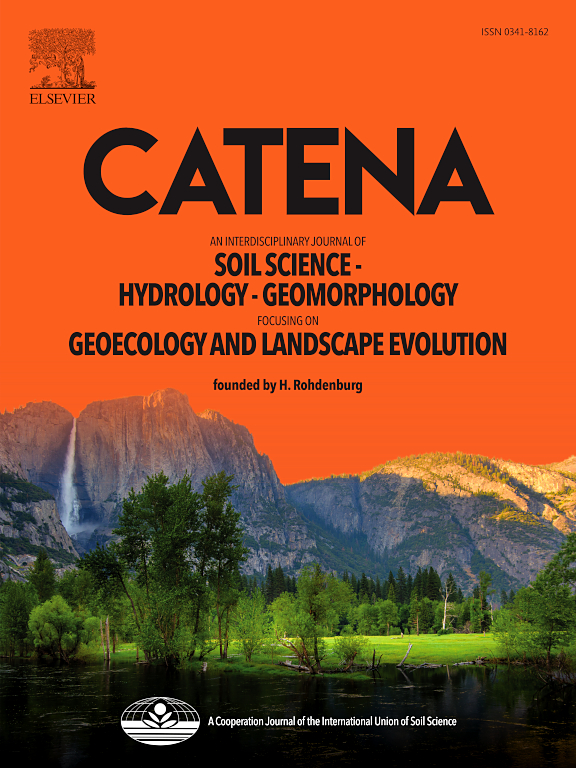无人机-激光雷达衍生 DEM 的空间分辨率对黄土高原丘陵沟壑侵蚀模型的影响
IF 5.4
1区 农林科学
Q1 GEOSCIENCES, MULTIDISCIPLINARY
引用次数: 0
摘要
高分辨率数字高程模型(dem)(例如<;10 m)对于推导地形变量和建立侵蚀模型至关重要。然而,不同的高DEM分辨率对侵蚀模拟结果的影响很少得到评估,特别是在地形复杂的地区。在本研究中,基于无人机光探测和测距(UAV-LiDAR)获取的三维点云,在黄土高原丘陵沟壑区的一个小集水区生成了不同分辨率(0.1 - 20 m)的dem。采用水耕侵蚀模型和输沙模型(WaTEM/SEDEM)模拟不同分辨率下的侵蚀过程,并基于无人机-激光雷达dem的差异结果对20 m分辨率下的结果进行验证。以20 m分辨率为基准,研究了DEM分辨率对不同地貌单元提取的地形因子和建模结果的影响。模型验证表明,WaTEM/SEDEM能够较好地模拟研究流域的土壤侵蚀和沉积(0.51≤NSE <;0.6, r = 0.75)。结果表明:随着DEM分辨率的粗化,平均坡度减小,坡长、坡陡和坡长(LS)因子和土壤流失量增大,泥沙淤积先增大后减小;在不同分辨率下模拟的侵蚀和沉积空间格局与基准分辨率相关的空间格局具有中等的一致性(0.46 <;卡帕系数<;0.51),并且随着分辨率接近基准,一致性增加。DEM分辨率对流域坡度、坡长、LS因子和水土流失量的影响大于坡面,小于沟面,而对流域沉积的影响也大于沟面。对产沙量的影响更为复杂,是侵蚀和沉积的综合影响。本文章由计算机程序翻译,如有差异,请以英文原文为准。
Impacts of spatial resolutions of UAV-LiDAR-derived DEMs on erosion modelling in the hilly and gully Loess Plateau
High resolution Digital Elevation Models (DEMs) (e.g. <10 m) are critical for deriving topographic variables and thus erosion modelling. However, impacts of varying high DEM resolutions on erosion modelling results have been rarely assessed, particularly for topographically complex areas. In this study, DEMs with varying resolutions (0.1−20 m) were generated based on 3D point clouds acquired by Unmanned Aerial Vehicles Light Detection and Ranging (UAV-LiDAR) for a small catchment in the hilly and gully Loess Plateau. Water and Tillage Erosion Model and Sediment Delivery Model (WaTEM/SEDEM) was employed to simulate erosion processes at different resolutions, with results at 20 m resolution being validated based on differencing results of UAV-LiDAR-derived DEMs. Impacts of DEM resolutions on topographic factors extracted and modelling results for different geomorphic units were investigated, with results at 20 m resolution as a benchmark. Model validation demonstrated that WaTEM/SEDEM was able to fairly simulate soil erosion and deposition in the study catchment (0.51 ≤ NSE < 0.6, r = 0.75). Results showed that, as DEM resolutions coarsened, average slope gradient decreased, slope length, slope steepness and slope length (LS) factor and soil erosion volume increased, while sediment deposition volume firstly increased then decreased. Spatial patterns of erosion and deposition simulated at different resolutions showed a moderate consistency to those associated with benchmark resolution (0.46 < Kappa coefficient < 0.51), and the consistency increased as the resolution approached the benchmark. Impacts of DEM resolutions on the derived slope gradient, slope length, LS factor, and soil erosion volume over the study catchment were greater than those for hillslopes while less than those for gully slopes, while the impacts on deposition were also greater on gully slopes than over the catchment. The impacts on sediment yield were more complicated as a combined effects on erosion and deposition.
求助全文
通过发布文献求助,成功后即可免费获取论文全文。
去求助
来源期刊

Catena
环境科学-地球科学综合
CiteScore
10.50
自引率
9.70%
发文量
816
审稿时长
54 days
期刊介绍:
Catena publishes papers describing original field and laboratory investigations and reviews on geoecology and landscape evolution with emphasis on interdisciplinary aspects of soil science, hydrology and geomorphology. It aims to disseminate new knowledge and foster better understanding of the physical environment, of evolutionary sequences that have resulted in past and current landscapes, and of the natural processes that are likely to determine the fate of our terrestrial environment.
Papers within any one of the above topics are welcome provided they are of sufficiently wide interest and relevance.
 求助内容:
求助内容: 应助结果提醒方式:
应助结果提醒方式:


